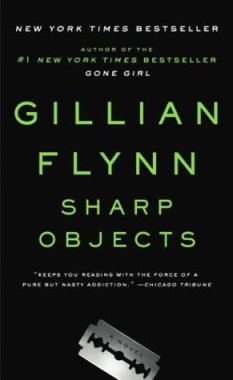After reading Gone Girl (twice) and blogging about it (twice), I finally moved on to Gillian Flynn’s two previous novels. When I mentioned reading Dark Places, several coworkers asked, “Do you like it better than Gone Girl?” While I was reading Sharp Objects, they asked, “Is it as good as the other two?” I love discussing books with my coworkers, but these questions didn’t inspire me. Sure, I like a good ranking as much as the next girl. But when reading multiple books by a talented writer, I’m more interested in how each book expands my understanding of her work. Comparing and contrasting, certainly, but on a deeper level than “this beats that.”
The easy answer is that I like different aspects of each book, but that’s hardly delving deep. As someone who rarely reads mysteries, I have to wonder what draws me to Flynn in the first place. For starters, her books are psychological thrillers, focused more on twisted character relationships than action and intrigue. As discussed in previous posts, the characterizations in Gone Girl are top-notch. Her earlier work displays the same talent, although the protagonists are more isolated, unlike the toxic married couple at the center of Gone Girl. The conflict is I-don’t-trust-anyone versus I-don’t-trust-you.
Dark Places and Sharp Objects also scared me on a level that Gone Girl never did. It probably didn’t help that I was usually reading them alone in my apartment, but there must be something else at work. Both earlier novels involve crimes against children, which is bound to be creepier than crimes against adults. And because the protagonists aren’t a golden couple, but rather damaged and isolated women, their vulnerability is keenly felt by the reader. I have to admire Flynn for creating these women, tossing aside feminine delicacy and discussing their flaws without flinching.
Maybe that’s why I read her books: to practice the art of not flinching. Interviewers often ask Flynn about her unflattering portraits of women, to which she responds that it’s time to acknowledge that women aren’t all softness. Women engage in different types of violence and cruelty than men, but they have the potential to be equally damaging. (Any girl who’s lived through middle school should know that.) Sharp Objects particularly explores this theme by focusing on toxic mother-daughter relationships, but Dark Places also contains a wide range of flawed women. Would this even be a topic of conversation with a primarily male cast of characters? Probably not, because we’re accustomed to seeing men as both villains and heroes.
Another appealing facet of Flynn’s novels is the Midwestern setting. There are countless mysteries and thrillers set in forbidding cities, but Flynn sees the potential for menace in small-town bars and decrepit farmsteads. Although Missouri is not Minnesota, her images often feel eerily familiar. More and more, I appreciate writers with a strong sense of place. All three of her novels have ambience up the wazoo. The Shadow of the Wind, one of my all-time favorite books, transports me to Barcelona, and Flynn’s act of literary teleportation feels no less miraculous.
I would like to discuss each book more specifically, but the word count is already creeping up. I also hesitate to reveal too many plot points because uncertainty is crucial to the roller coaster reading experience of these books. Not everyone who liked Gone Girl will like Sharp Objects and Dark Places. But if you have the stomach for it—if you want to practice not flinching—they are gripping reads.



